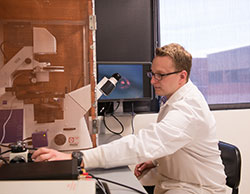Tiny Tools, Big Results
Chemist Ryan White works to transform research on how brain cells communicate with each other.
In his chemistry lab at UMBC, assistant professor Ryan White peers through the microscope at a 25 um sensor, the size of a single strand of hair. Attached to the sensor, beyond the realm of microscopic resolution, are DNA aptamerssingle strands of DNA that can change shape when molecules bind to them. The material White works with is incredibly tiny, but it has the potential to lead to remarkable insights.
The brain is a complicated place, says White. In the last 100 years scientists have focused on neurons. Theyre thought of as the main player, he explains. Other cell types in the brain have been overlooked and it turns out that some of them are essential partners in brain function. That means, says White, that scientists now need tools to study interactions between neurons and other brain cells.
White and his team are interested in looking at astrocytes, a type of support cell in the brain. There is evidence that communication between astrocytes and neurons is important in a genetic disorder called Fragile X syndrome, one of the few known genetic causes of autism spectrum disorder.
It turns out that healthy astrocytes can help repair the abnormal neurons. However, not much is known about the communication between astrocytes and neurons. White and his team aim to develop a toola tiny sensorthat will help scientists study the interactions between these two cell types.
White makes the sensor by inserting a piece of gold wire into a micropipette. The pipette is pulledfashioned into a polished glass needle with a gold disk at the end. Attached to the gold disk are aptamers. When an aptamer changes shape White is able to record an electrical signal that allows him to calculate how many molecules of ATP are released. Right now were looking at tens to thousands of molecules, he says.
ATP is typically thought of as the energy currency of the cell, but in this case White and his team are looking to see if cells communicate with each other through ATP. The big question: is there a hotspot for ATP activity in the astrocyte and can White determine the mechanism of ATP release? Answers to those questions could help White and his collaborator, Mary McKenna at the University of Maryland School of Medicine, unravel some of the mysteries behind Fragile X syndrome.
White doesnt plan to stop with Fragile X syndrome. The most exciting thing about the sensor, he says, is we can just change out the aptamer to look at different molecules that may hold the key to answering other important questions in science and medicine.
White, who joined UMBC in 2011, also has a vision for research that goes beyond the microscope. His research builds on his experiences as a graduate student at the University of Utah and a post-doc at the University of California, Santa Barbara, but White attributes much of his success in science to an undergraduate research experience at the University of North Carolina, Chapel Hill. He shares, I dont think without that I would be where I am today.
Now White is carrying on that tradition. His lab currently includes four undergraduates and two graduate students. Two of his former undergraduates, Samiullah Sam Wagan 13, biology, and James Taylor 14, chemistry, have gone on to careers in science and medicine. Wagan is a medical school student at the University of St. Louis and Taylor is a graduate student in chemistry at the University of North Carolina, Chapel Hill.
White says Wagan and Taylor were integral to lab experiments while at UMBC and published their research alongside graduate students. He believes its essential to give undergraduates projects they can make their own, rather than assigning them minor tasks simply supporting other research, as is the norm at many other universities. This is your chance to get hands on experience, he tells them, Your project is not set in stone.
I encourage undergraduate students to formulate their own questions in the lab, White explains. Even if their projects dont work out as planned, he notes, that is a valuable lesson if they want to go on in research.
Whites lab demonstrates how, by working together on complementary projects, undergraduate and graduate students can contribute the fresh perspectives that research thrives on as they develop into the next generation of innovative scientists.
(03/19/2015)
© University of Maryland, Baltimore County 1000 Hilltop Circle, Baltimore, MD 21250 410-455-1000

